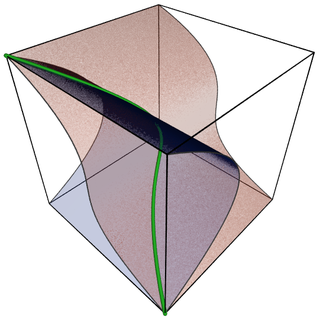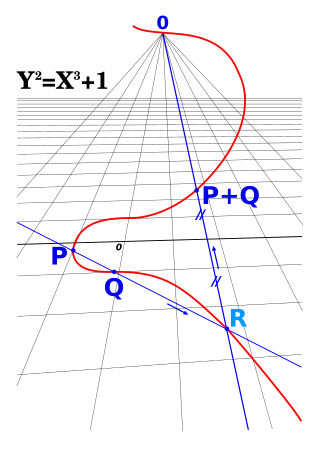
Faltings's theorem is a result in arithmetic geometry, according to which a curve of genus greater than 1 over the field of rational numbers has only finitely many rational points. This was conjectured in 1922 by Louis Mordell, and known as the Mordell conjecture until its 1983 proof by Gerd Faltings. The conjecture was later generalized by replacing by any number field.

In mathematics, particularly in complex analysis, a Riemann surface is a connected one-dimensional complex manifold. These surfaces were first studied by and are named after Bernhard Riemann. Riemann surfaces can be thought of as deformed versions of the complex plane: locally near every point they look like patches of the complex plane, but the global topology can be quite different. For example, they can look like a sphere or a torus or several sheets glued together.

In mathematics, complex geometry is the study of geometric structures and constructions arising out of, or described by, the complex numbers. In particular, complex geometry is concerned with the study of spaces such as complex manifolds and complex algebraic varieties, functions of several complex variables, and holomorphic constructions such as holomorphic vector bundles and coherent sheaves. Application of transcendental methods to algebraic geometry falls in this category, together with more geometric aspects of complex analysis.

In mathematics, particularly in algebraic geometry, complex analysis and algebraic number theory, an abelian variety is a projective algebraic variety that is also an algebraic group, i.e., has a group law that can be defined by regular functions. Abelian varieties are at the same time among the most studied objects in algebraic geometry and indispensable tools for much research on other topics in algebraic geometry and number theory.

Algebraic varieties are the central objects of study in algebraic geometry, a sub-field of mathematics. Classically, an algebraic variety is defined as the set of solutions of a system of polynomial equations over the real or complex numbers. Modern definitions generalize this concept in several different ways, while attempting to preserve the geometric intuition behind the original definition.

In algebraic geometry, a projective variety over an algebraically closed field k is a subset of some projective n-space over k that is the zero-locus of some finite family of homogeneous polynomials of n + 1 variables with coefficients in k, that generate a prime ideal, the defining ideal of the variety. Equivalently, an algebraic variety is projective if it can be embedded as a Zariski closed subvariety of .
In mathematics, a scheme is a mathematical structure that enlarges the notion of algebraic variety in several ways, such as taking account of multiplicities and allowing "varieties" defined over any commutative ring.

David Bryant Mumford is an American mathematician known for his work in algebraic geometry and then for research into vision and pattern theory. He won the Fields Medal and was a MacArthur Fellow. In 2010 he was awarded the National Medal of Science. He is currently a University Professor Emeritus in the Division of Applied Mathematics at Brown University.
In mathematics, the Jacobian varietyJ(C) of a non-singular algebraic curve C of genus g is the moduli space of degree 0 line bundles. It is the connected component of the identity in the Picard group of C, hence an abelian variety.

In mathematics, a complex analytic K3 surface is a compact connected complex manifold of dimension 2 with а trivial canonical bundle and irregularity zero. An (algebraic) K3 surface over any field means a smooth proper geometrically connected algebraic surface that satisfies the same conditions. In the Enriques–Kodaira classification of surfaces, K3 surfaces form one of the four classes of minimal surfaces of Kodaira dimension zero. A simple example is the Fermat quartic surface
In mathematics, the Albanese variety, named for Giacomo Albanese, is a generalization of the Jacobian variety of a curve.
In algebraic geometry, the Kodaira dimensionκ(X) measures the size of the canonical model of a projective variety X.
Continuation of the Séminaire Nicolas Bourbaki programme, for the 1950s.
This is a glossary of arithmetic and diophantine geometry in mathematics, areas growing out of the traditional study of Diophantine equations to encompass large parts of number theory and algebraic geometry. Much of the theory is in the form of proposed conjectures, which can be related at various levels of generality.
In mathematics, the Schottky problem, named after Friedrich Schottky, is a classical question of algebraic geometry, asking for a characterisation of Jacobian varieties amongst abelian varieties.
In mathematics, the Abel–Jacobi map is a construction of algebraic geometry which relates an algebraic curve to its Jacobian variety. In Riemannian geometry, it is a more general construction mapping a manifold to its Jacobi torus. The name derives from the theorem of Abel and Jacobi that two effective divisors are linearly equivalent if and only if they are indistinguishable under the Abel–Jacobi map.
This is a timeline of the theory of abelian varieties in algebraic geometry, including elliptic curves.
This is a glossary of algebraic geometry.

In mathematics, a Siegel modular variety or Siegel moduli space is an algebraic variety that parametrizes certain types of abelian varieties of a fixed dimension. More precisely, Siegel modular varieties are the moduli spaces of principally polarized abelian varieties of a fixed dimension. They are named after Carl Ludwig Siegel, the 20th-century German number theorist who introduced the varieties in 1943.









